Askeladden school-cooperation project
Supported by University of Oslo
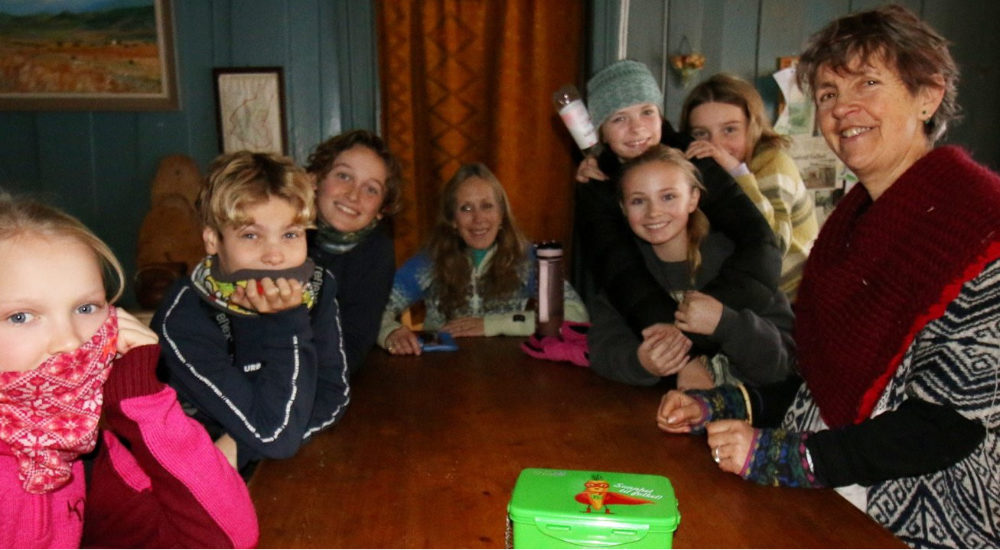
We were contacted by UiO to apply for a project with a local school. We were lucky enough to receive the maximum amount of support for:
“Digging in the ashes – can Asbjørnsen and Moe’s fairytales contribute to sustainability?”
BACKGROUND
November 2023 began collaboration between Tangen school in Stange and Opsal gård, center for storytelling about Biodiversity. 22 pupils from 6th and 7th grade as well as 2 teachers were directly involved and the whole school worked on storytelling and sustainability for the whole month. The project was supported by Skole i verden from the University of Oslo, and two teachers represented Tangen school at the conference in Oslo
The students explored Norwegian fairy tales and fairy tale performance (a highly sustainable form of entertainment) to promote creativity and imagination in the context of a sustainable lifestyle. Tangen School works with the UN’s Sustainable Development Goals, and this interdisciplinary project was integrated into the subjects KRLE / Religion and ethics, Science, Norwegian, English, Arts and crafts and Social studies / Social studies.
A young Danish pedagogue and storyteller, Jacob Slaatto worked as an apprentice storyteller during this period and followed the project throughout, as well as 4 volunteers from France and Germany who worked on the farm. The project began with a visit to the school with storytelling, riddles and games to get to know the students a little.
Following the project, we did an evaluation together with Bjørnar and Kristin from Tangen and the two storytellers, also the principal of Tangen school – Eli Martinsen and Martin Lee Mueller from the University of Oslo attended the meeting.
We discussed how physical work, contact with the animals and the trees had a significant effect.
The first meeting with the students at the school showed us that this was a group that wanted to participate. They were alert and curious. One boy who got a little distracted during the stories was one we never had a problem with afterwards and became one of the best storytellers of all. The teachers pointed out that such a scheme is especially valuable for such students.
The teacher with the longest experience from the school said: ‘In the past, it was much easier to get out and experience, for example, skinning an elk. Now it’s difficult. But we see that the students get a lot from such experiences.’ The school also appreciated that the days were so varied, we were inside and outside and alternated a lot between activities with different challenges. They also mentioned that both the activities and the discussions gave them useful ‘pegs’ to use in discussion and the understanding of concepts.
We discussed the phenomenon of ‘paralysis of enormity’; that young people have so much to deal with that it can be difficult to know where to start. But the experiences they have had in the project give them a starting point. This mirrored the goal we have had to help reduce anxiety through activities that can contribute to a brighter future.
The stories from Norwegian folk culture have clearly built self-confidence, there were several students who performed far beyond expectations and one of the teachers said ‘they have worked and seen everything in fairy tales in a practical way and then it is much easier to tell.’ important principle within storytelling.
Summary of activity during the project:
Session 1
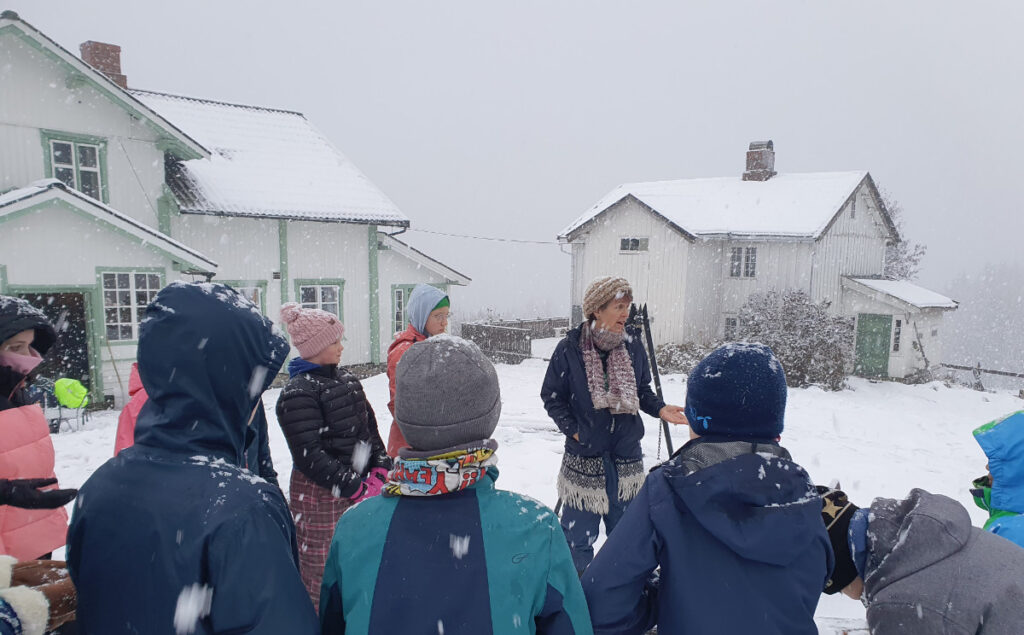
On 7 November the class came to Opsal farm for the first time. A day packed with activities. We started by feeding the pigs with food that would have been thrown away at home, everyone was happy, of course not least the pigs and it was explained how the pigs work as tractors on the farm and contribute to biodiversity by digging in the soil.
Then we got to play hide and seek in the various buildings on the old farm. Then the students were shown and learned a bit about how people in the old days or the time of fairytales could be completely self-sufficient. The young volunteers who live here now (who have come by train from Europe) guided them in English. The school students took the challenge of speaking English.

Then we split the group into three groups.
Some learned about the problems with spruce spreading on pasture and together we felled a rather large spruce tree.
It was a great and exciting experience to do this while the snow was falling.
Group two lit wood stoves and learned about emissions in relation to different types of heating, then they put sticks in the stove to be transformed into charcoal for drawing and made washing-up liquid from the ashes. Group three started whittling wooden spoons. Then there was one more game and two fairytales. The day ended with cuddling the pigs and a snowball fight.
Session 2
After the pigs had been given the leftover food again, we held a competition which consisted of three tasks:
a. find leaves from different types of trees
b. identify tree species
c. make a map showing where the tree species are on the farm
We had put signs by the trees in the forest garden, but they didn’t get to write down the names, and had to remember. Then they went on around the farm and collected leaves. Then they drew the leaves and named the species of tree they recognised. Then they drew maps of where the trees grew. The competition ended on the last day.
They were again divided into 3 groups and participated in the other activity that they had not done in the previous session. Chopping wood / nailing / lighting ovens, making charcoal, preparing apples to be roasted in the wood oven.
After lunch, Jacob and Georgiana told two new long fairytales from Asbjørnsen and Moe. By then the pupils had listened to 6 stories and were divided into groups of 3 or 4. Then work began with a story in each group. First by retelling the story to each other. Then they came out and made a narrative installation in the snow. They showed their installation to another group. There was a lunch break with baked apples. When they heard that the apples had been harvested from the rubbish outside the shop some were shocked, but when we told them they were washed every last one was eaten with gusto. Then came washing dishes with washing-up liquid left from ashes last time.
After another old-fashioned game – blind mans buff, we did the Dialogue exercise. This is a activity devised by Beate Børresen, Master in History of Ideas from the University
of Oslo and docent emerita at the Faculty of Teacher Education, Oslomet. Georgiana has used the technique before and it consists of making statements. The students must decide what is true or false. They do this physically, by standing by a rope marked with true and false at each end. Then they discuss why they have chosen to stand in this place – The statements we took were:
• It is disgusting to collect food from the rubbish
• You can insulate with completely natural products (we have recently used moss for insulation)
• Nobody cares about animals
• There are almost as many emissions from the internet as from flights (figures show that the internet now produces more emissions than air travel)
• It was boring in the old days without a telephone
• Norwegians fly more than anyone else in Europe
• If you are a vegan, there is not much you can eat
• Rich people are self-absorbed egoists
• Nobody plants trees (Who plants the most trees in the world? – squirrels)
• Washing-up liquid must be bought (now they have experienced something else)
• Old clothes are ugly
We received feedback from the teachers that there were several students who do not usually speak up who became very engaged and shared a lot.
Snowball War!
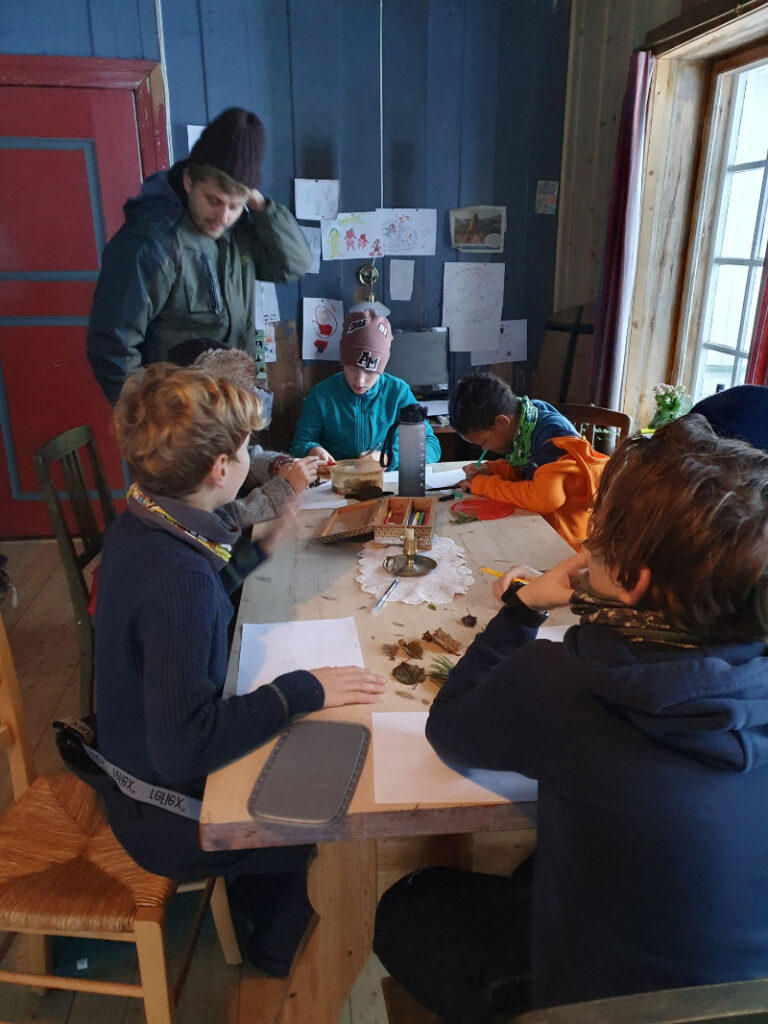
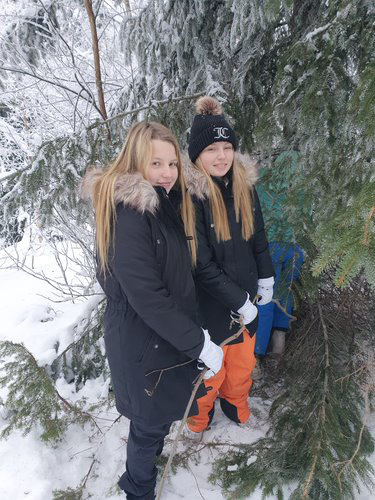
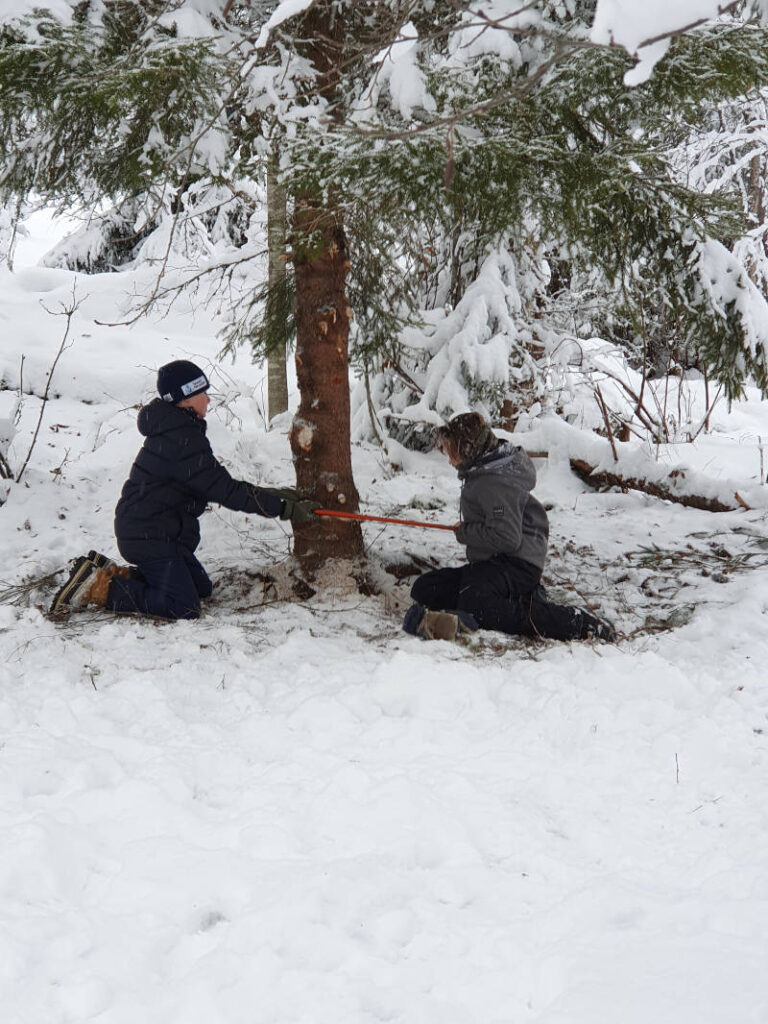


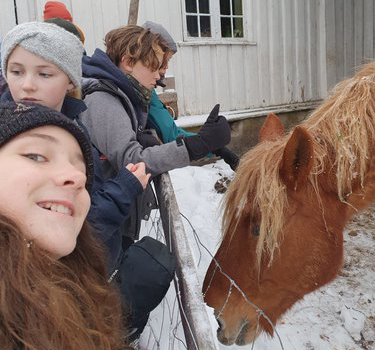
Without being reminded, they brought more food for the pigs.
Some brought carrots for the horses.
They were asked why we have horses and learned a little more about grazing and its importance for biodiversity and the use of horses for work on the farm.
SESSION 3
Then it was back to work on the stories. The tales were to be retold the following day to younger grades. First they started miming the story. Then they told the story from the point of view of a character who is not the hero or heroine. Then they drew the story using charcoal that was made last week from birch and willow – what’s the difference?
Then they were again divided into 3 and took the remaining activity which they had not done previously.
After lunch, it was hide and seek again and showing the buildings that they had not seen before. Then there was an exercise to get to know a tree and then into the warm.
Then the group was divided into three and answered the big question – What is sustainability? Can you give an example? In addition to more common answers such as waste sorting, there were many examples of things that they had been involved in during the project. Like making washing-up liquid, whittling one’s own spoons, eating food that should have been thrown away. Then we asked what it is that they are thankful for? Here there wer also good contributions from our young volunteers – she is grateful for water. In addition came family, peace, friends, food. No-one mentioned gratitude for things which can be bought at the shop.
How do you personally feel in relation to living sustainably? Here there was a lot of focus on trees. Also animals, insects, climate change, plastic. One girl said that she is afraid we are cutting down too many trees so that there is not enough oxygen and she will die. It was a good opportunity to learn that not only trees but moss, the sea, even soil can be decisive in relation to emissions.
Last question – What is in your story that relates to sustainability? Many suggestions came here – several had noticed that in the fairytales the characters don’t drive but walk. One noticed that the heroine made clothes from plants, and one that a tree can be the mother and father of a whole forest of saplings.
During the break we ate fruit crumble, which the students had baked with currants from the farm.
Then they had time to work on one last session with the story before they told to each other 3 and 3. Storytelling at this age is not easy, and the stories they had been given were quite long and out of the ordinary. We think they did well.
Prizes were awarded for tree competition and then they took spoons with them to finish at school.
Afterwards there was an exchange of gifts between the pupils and the young volunteers and a video is made of the pupils storytelling which will be shown at the Christmas party at school.
Further cooperation
From the storytellers on the farm came a concrete proposal. We want the students to experience that they contribute in a more visible and direct way to biodiversity and sustainability. We are working on expanding the streams on the farm to form a larger area of wetland. The next project could be that we work ‘like beavers’ to make small dams along all the streams. It would be extraordinary if a real beaver was to move in here, but in any case this would contribute to increased species diversity. It would be even more meaningful if we could involve someone with in depth knowledge of the beaver.
The school seemed positive about this idea and think they can contribute something financially, of course not large sums, but it showed us their interest!